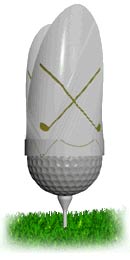|




|
Golf from Two Sides
By Roger and Joyce Wethered
1922

Quoting from pages 178 to 182. (Joyce Wethered born in1901 in Surrey, England — was a golfer widely regarded as the greatest British woman player of her time. Wethered and her brother Roger, who tied for the British Open title in 1921 but lost the play-off, learned the game as children. She won the British Ladies Amateur Golf Championship four times (1922, 1924, 1925, and 1929) and English Ladies' champion for five consecutive years (1920–24). After her marriage in 1924, she was also known as Lady Heathcote-Amory).
“I have heard it said that it is a mistake for ladies to play from the men's back tees, on the ground that, by doing so, the hole loses its primary intention for them. A course consists of a certain proportion of short holes; and others, varying from considerable length to the medium distance, requiring a drive and an iron approach. Played from the back tees, such a course meets the requirements of the men. What happens if the ladies play from them? They have the short holes—which are not nowadays always too remarkable for their shortness—and the rest reach excessive proportions, from the point of view of their powers of striking. This may be said to ruin the intention of the course, so far as the ladies are con¬cerned; and the argument might be developed so far as to stipulate that, when one particular hole is intended for a drive and an iron for a man, it should provide the same shots for a lady.
I can suggest an answer to this argument: that ladies as a rule do not mind a lot of wooden-club play through the green; it is a game that comes naturally and easily to them, and they would if anything prefer to peg away with wood rather than have to emulate their men with their irons. However that may be, team matches have been played on an allowance of distance's and in these cases, I believe, the ladies showed up better than when they played off the same tees as the men.
But the fact remains that it makes a much less interest¬ing and less intense competition and it becomes a more lonesome game when the players part company on the tee and drive off in solitary state from their separate stations. The matches at Stroke are great fun, and it would be a thousand pities if the mixed warfare were taken too seriously or the ratios of mathematical discrepancy too closely insisted upon. The one thing that does count against the ladies on that course is that strength tells very considerably in playing the long iron shots up to the green. As I have already said, this is not a typically ladylike shot, in the sense that the lady rarely excels in the knack of hard hitting. The effect is rather devastating, when Mr. de Montmorency plumps the ball with his irons from long distances on to the green with the least apparent diffi¬culty. That must, from necessity and admiration, be suffered gladly, in the hope that some day even a feeble imitation might come within one's scope. In the meantime, the only thing for the ladies to do is to steadily improve the standard of their game, chiefly by concentrating on the best models of iron play, and in the near future, by means of that half, to prevent the men from being tempted to take things too easily and to make them fight hard to escape the day of retribution.
So far we have discussed the opposition of men and women in match play. There remains the question of stroke competition. As far as I know, only one experiment has been made in an open competition when some form of comparison has been attempted with regard to medal play. At St. George's Hill ladies were invited to compete in a mixed field with the basis of their L.G.U. handicaps, plus an additional six strokes. Considering the meticulous care which, is taken by the L.G.U. to avoid over-inflation in their handicap figures, I consider this extra allow¬ance to be a very liberal one. I hope I am not speaking with undue optimism if I express the opinion that on these terms the first prize ought to be more or less of a gift to some lady who happens to be right on her game at the time. But this is primarily a handicap question, which is best left to the experts for solution.
The newest development in mixed competitions was recently inaugurated by the Worplesdon Club, when they organised a mixed Foursome Tournament on the lines of the better-known lawn tennis model. The result was an unqualified success, not only as a social function but also from the point of view of the high standard of play displayed by both parties. This came indeed as a considerable surprise to most people. As one player said—possibly with a touch of irony— the surprising thing was not so much how well the ladies played, as how their partners excelled themselves. At any rate, there is no doubt that all those concerned rose to the occasion and produced of their best. It could scarcely have been predicted, even by the most imaginative prophets, that within two days of Mr. de Montmorency establishing a competition record of seventy by quite exceptional golf, any mixed four¬some couple would have made a habit of going out in thirty-six, and keeping up an average in the close neighbourhood of fours for most of the round. Yet this was done in several matches; and what is more, it was often necessary to produce this kind of golf to win.
It practically amounted to a mixed pair doing as well as a pair of first-class men, and went far to suggest that the ladies must have at least played their short game as well as their partners, and, backed up by superlative assistance from the tee and through the green, were able to contribute a number of shots which were sufficiently good to keep the figures at a surprisingly low level.
This leads us to inquire where the difference in play actually exists. There is a wide gulf fixed at any rate by the one factor of physical strength. Only by handicap adjustment can equality be established, which at once rules out the possibility of too serious a rivalry. Only by shortening courses to an uninteresting length could even chances be brought about, and back tees are the very essence of modern golf, which demands long hitting. If, for the sake of argument, we take it for granted that no self-respecting plus man will fail nowadays in reaching a green with his second— this is an assumption made only for the sake of argu¬ment—it is possible to calculate on four fairly represen¬tative courses, which I have in my mind, the number of holes at which a good lady player would require three strokes to obtain the same distance. On two out of these four courses the number of such holes would work out at nine or ten. On the other two courses the lady would require three strokes at least to reach seven of the greens. Putting the short game as giving equal chances to both—again an assump¬tion, which is arguable but not necessarily outside the realms of possibility—it becomes apparent that on the majority of courses, in point of strength alone, apart from questions of superior skill, a difference of seven to ten strokes enters into the case. If the reply is made, that an allowance of an extra six strokes in medal play has been stated to be rather in the ladies' favour, it must be remembered that the systems of handicapping are at the present moment adjusted on different prin¬ciples, with the result that a four handicap lady may as likely as not be in the same class as a man with a similar figure to his name. Or to put it otherwise, a four handicap man might find it difficult work to concede more than a modicum of strokes, if any, to a lady similarly placed according to her method of rating. Taking everything into consideration, the only safe conclusion appears to be that, making due allow¬ance for the severe or comparatively easy nature of any particular course, the correct odds between men and women who occupy similar positions in their respective ranks in regard of merit would work out between seven and nine strokes.”
|






